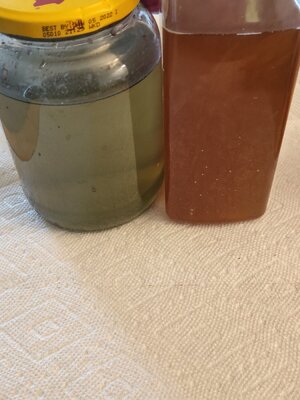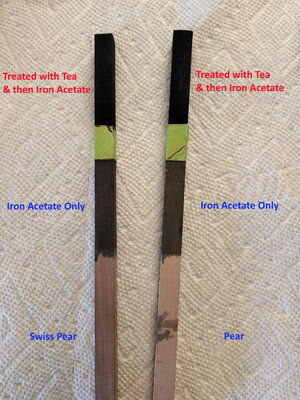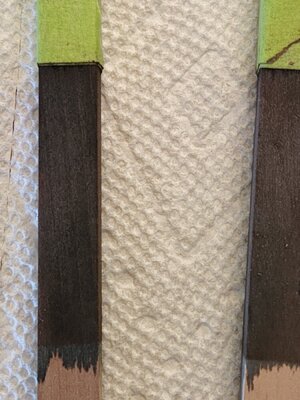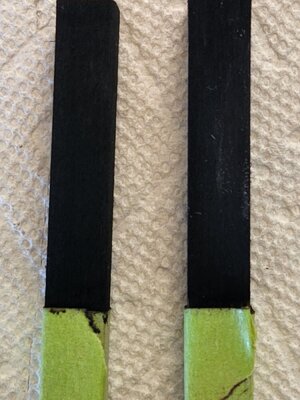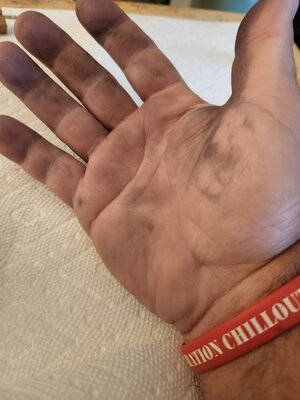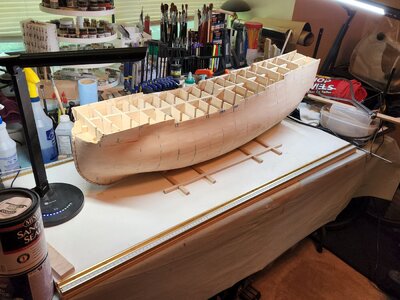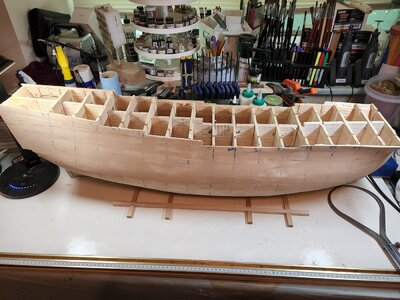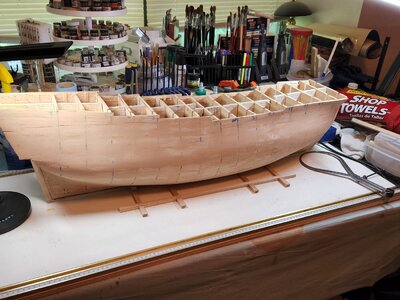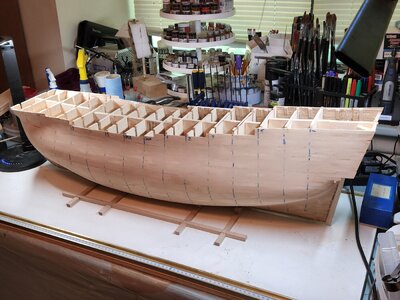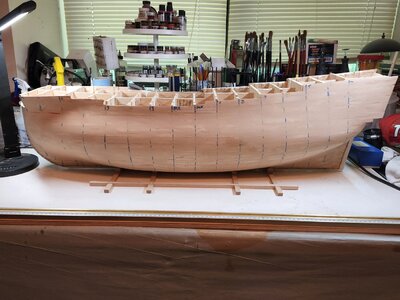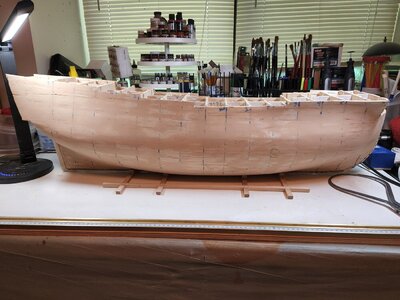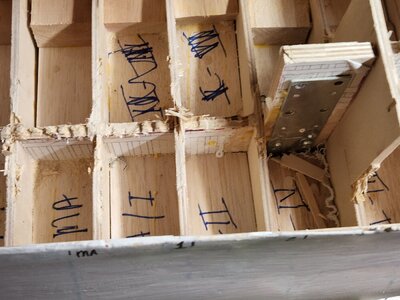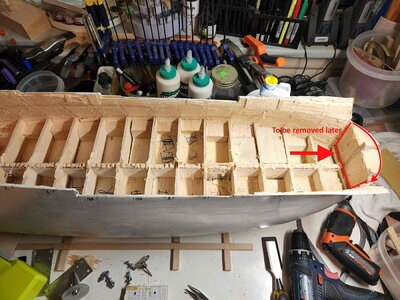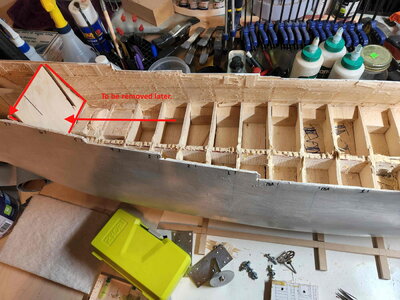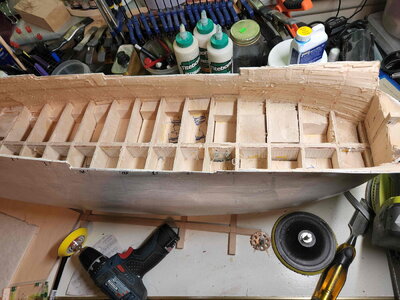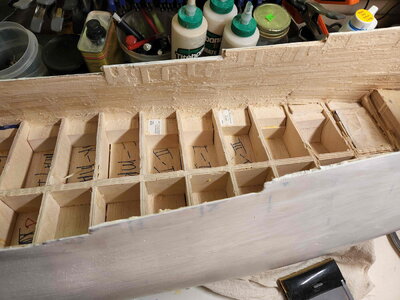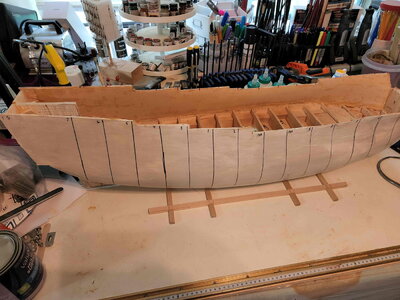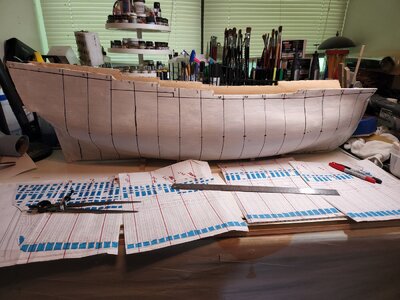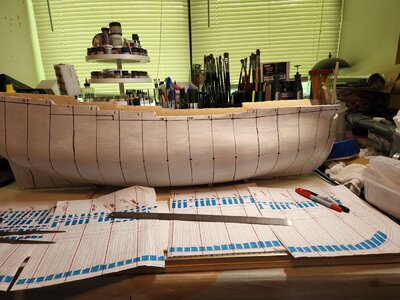Hello Everyone,
So throughout this build I will be multitasking. While waiting for glue to dry or just when I need a break from what I'm doing, I'll "change gears" and do some testing, where I need to to understand my options for future tasks or the way to build certain ship elements or treat wood, etc.
I have finished the 3rd layer of shell planks and rough sanding. I've coated the hull with a diluted PVA solution and waiting for it to dry. In the meantime I wanted to share my findings on a test I just finished.
Test: Ebonizing Wood
A while back I was looking for an option to working with Ebony or purchasing Black Hornbeam as it was hard to find and expensive. Dave Stevens responded to my request with a post on ebonizing woods.
poking around in the log pile I found a short log of box elder a member of the Maple family What caught my eye is the ripples in the log this indicates a figure that will look something like this, I can also see different colors in the log. right now it looks a dirty gray color and all wood...
shipsofscale.com
I watched many videos and read a few posts, but still needed to see for myself.
The wood I tested needed to be a wood that milled well. Also, because this process works the best with woods with a good tannin content, I did not test Boxwood or Castello Boxwood. I chose Pear and Swiss Pear.
Ebonizing Solutions
Iron Acetate
Iron Acetate is the actual ebonizing solution. Your can apply brush it onto wood and it will turn the wood darker. The depth of ebony color it imparts depend on the wood's tannin content. I'm not sure if you can purchase it commercially. I did not look. So I made mine. You can find the recipe on almost every video or article about ebonizing wood. I will share the way I made mine. It is quite easy.
Recipe
I should have taken photos of the steps, but did not. I did not measure anything exactly. I do not think it matters, other than the general ratio
1.) Steel wool, the finest I could find(0000). Soak it in warm water with some dish soap to remove any oils, which will allow it to react more readily. I wore Nitrile gloves and rinsed under warm water until all the soap was washed away. Then put in the oven @ 200F until dry.
2.) I tore apart the steel wool to make it less dense. Then place the pieces into a glass jar until it filled it to the top. I did not press or force it in. Glass is used as it will not react or interfere with the chemical reaction.
3.) I poured Whit Vinegar into the glass jar until it covered all of the steel wool. Securely placed a lid on the jar and put it away for 5 days.
Some recipes call for Apple Cider Vinegar as it has the highest acetic acid content of all the vinegars, although White Vinegar worked fine for me.
4.) After the 5 days, I strained the liquid through a coffee filter to remove all solids.
Most of the steel wool was dissolved. What solids were left looked more like sludge than steel wool. What was left was a liquid that was a little cloudy.
Tea
While the Iron Acetate is the actual solution that ebonizing the wood, tea is a catalyst to make it more effective. This is because the tea contains tannins. By applying tea to the wood prior to applying the Iron Acetate, it creates a darker shade of
Black. While I don't think I need to provide a recipe for tea

, it is important to note, the darker the tea, by type of tea is important as they contain a higher level of tannins. Also, the stronger the brew of that tea seems to make it even more effective.
Below are the two solutions. Iron Acetate on the left and Tea on the right, if it's not obvious, or for anyone colorblind.
 View attachment 326352
View attachment 326352
So for the test I took two 10mm X 10mm wood sticks, one Pear and the other Swiss Pear. I used painters tape to separate the treated areas. The photo explains the results.
View attachment 326355
Very good results were realized. Also, even though the Swiss Pear seemed a little darker, it was negligible. Close ups below.
View attachment 326358View attachment 326359
There are some unknowns still. One of them I need to discover is how deep does the treatment go into the wood. If I sand it, will it disappear? We will see. With that said, I think I would most likely complete the finish of the wood, i.e. cutting, forming, rough sanding prior to treatment, then seal it. Finishing ebonized wood is another test I need to perform. What will it look like with an oil or poly finish applied.
This is important to me as I will be using Black Hornbeam throughout the model and I would not like to have any significant appearance between the hornbeam and ebonized wood. If there is, I will not use this method.
The reason I performed this test was because I was looking at building trail board of the stem out of Black Hornbeam, but would have resulted in needless waste of expensive wood.
And while I used gloves when preparing the Iron Acetate, I did not wear them during the application process. This led to a little piece of trivia knowledge. It seems human hands contain tannins as well as wood.
 View attachment 326360
View attachment 326360
Hopefully this provides some useful information for those why might want to use it. I will be performing many more tests as it is my nature to understand things. I will be sure to share any that might have some value.
Until next time...
Cheers, and wear your gloves!!!!
Actually, I think I tested something like 2 specialized tools for removing staples I bought on Amazon, along with 6 or 7 types of pliers. The ones I am using now came out the winner.
I'm sure this is the moment where modelers get very nervous on their first scratch build. It is new territory for me and I will most likely ask the advice of people soon. I'm curious if I need to plot every point from the plan at each bulkhead and connect the points using French curves or use actual copies of the plans as stencils taped to the hull and plot the points that way.



